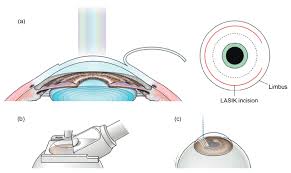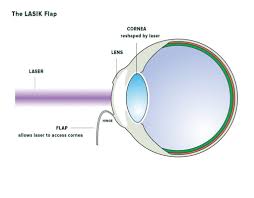Table of Contents
ToggleYes, LASIK can improve peripheral vision in certain cases, but it’s essential to understand the specifics of how LASIK influences different aspects of vision.
While the procedure is primarily aimed at correcting central vision issues like nearsightedness, farsightedness, and astigmatism, its impact on peripheral vision depends on various factors, including the patient’s condition and the health of their eyes.
For those considering LASIK, it’s crucial to know how the surgery works and whether it can address challenges related to peripheral vision. This blog explores the science behind LASIK, its effects on peripheral vision, and what patients can realistically expect from the procedure.

What Is Peripheral Vision?
Before evaluating LASIK’s potential to correct peripheral vision, it’s important to understand what peripheral vision is. Peripheral vision, or side vision, refers to the ability to see objects and surroundings outside your direct line of sight. It allows you to detect motion and maintain spatial awareness, critical for activities like driving, sports, and navigating. Unlike sharp central vision, peripheral vision lacks fine detail but is essential for detecting motion and maintaining balance.
Peripheral vision relies on the function of rods in the retina, which are sensitive to light and movement. While peripheral vision problems are less common than central vision issues, they can occur due to conditions such as glaucoma, retinal detachments, or neurological problems. This context is essential for understanding whether LASIK can address broader visual challenges.
Is LASIK Designed to Correct Peripheral Vision?
LASIK is primarily designed to reshape the cornea to correct refractive errors affecting central vision. These errors occur when the cornea or lens does not bend light correctly, causing blurry vision. LASIK uses advanced laser technology to reshape the cornea, helping light focus properly on the retina.
LASIK’s main focus is central vision correction, targeting issues like myopia (nearsightedness), hyperopia (farsightedness), and astigmatism. While it does not specifically aim to address peripheral vision, successful LASIK surgery can indirectly improve peripheral vision in certain cases. For example, if peripheral visibility is previously affected by a refractive error, reshaping the cornea could enhance overall visual clarity across the entire field of view.
However, if peripheral vision problems are due to retinal disorders, neurological issues, or other non-corneal causes, LASIK cannot resolve them.
How LASIK Influences Peripheral Vision?
Although LASIK is not directly tailored for treating peripheral vision, several factors may contribute to indirect benefits or changes post-procedure. Here’s how LASIK may affect peripheral vision:
1. Reduced Dependence on Corrective Lenses
After LASIK, many patients no longer require glasses or contact lenses. Corrective lenses can sometimes obstruct peripheral sight due to their limited size or shape, especially glasses with smaller frames. By eliminating the need for such lenses, LASIK often restores a more natural, unobstructed peripheral field, potentially offering patients improved awareness of their surroundings.
2. Improved Overall Clarity
For individuals suffering from significant refractive errors, blurry or distorted peripheral visuals may have been a side effect of their condition. When LASIK aligns the cornea properly, it can enhance sharpness across the broader visual field, leading to an indirect improvement in the peripheral region. However, how much improvement occurs depends on the individual’s initial condition.
3. Impact of Corneal Reshaping
During LASIK, the corneal reshaping process can influence the way light travels. The surgery focuses light more accurately onto the retina, improving how the brain processes visual information. While this mainly benefits central vision, some patients report slight enhancements in their outer field of view, particularly if their refractive issues were severe and previously impacted their entire vision.
4. Potential Side Effects
LASIK isn’t without risks, and some side effects can affect peripheral vision. Halos, glare, and starbursts around lights are common temporary side effects that may initially reduce sharpness in peripheral sight. These usually resolve within a few weeks to months after surgery. Speak to your surgeon if these issues persist, as they might indicate complications or the need for follow-up treatment.
LASIK and Peripheral Vision – Who Can Benefit?
Whether LASIK can help with peripheral vision depends on the root cause of the issue. Here’s a breakdown of cases where LASIK may or may not address peripheral vision challenges effectively:
1. When LASIK Could Indirectly Improve Peripheral Vision?
- Individuals with Refractive Errors: People who suffer from significant nearsightedness, farsightedness, or astigmatism may find their peripheral vision improving after LASIK as an extension of overall corrective adjustments.
- Those Dependent on Glasses or Contacts: Patients who relied on narrow-frame glasses that obstruct peripheral sight may experience greater freedom and natural peripheral clarity.
2. When LASIK Isn’t Effective for Peripheral Vision?
- Retinal Disorders: Conditions such as glaucoma, retinitis pigmentosa, or retinal detachment specifically affect peripheral awareness and are unrelated to the cornea. LASIK cannot address these conditions.
- Neurological Causes: Peripheral vision loss resulting from brain injuries or neurological disorders will not improve with LASIK since the problem lies in brain function rather than the eye’s shape.
- Eye Diseases like Cataracts: While cataracts obscure vision across the visual field, they require surgical intervention unrelated to refractive error correction.
What to Expect During LASIK Evaluation?
Before undergoing LASIK, a thorough eye examination is essential. Your ophthalmologist or LASIK surgeon will evaluate various factors, including:
- Corneal thickness and shape
- Degree of refractive error
- Your eye health and medical history
- Presence of conditions that may impact peripheral vision, such as glaucoma or retinal damage
Knowing the underlying cause of your peripheral vision concerns will help determine whether LASIK is suitable for your needs. Patients who experience issues unrelated to refractive correction may be directed to alternative treatments.
Alternatives to LASIK for Peripheral Vision Issues
If LASIK is ineffective or unsuitable for your peripheral vision concerns, consider other treatment options. These could include:
- Prescription Glasses or Contact Lenses Tailored to Peripheral Vision
Advanced lens technologies, including wide-frame glasses or specialised contact lenses, can provide expanded peripheral sight.
- Vision Therapy
Physical exercises and therapies guided by an optometrist may help strengthen overall vision and improve spatial awareness in certain cases.
- Medical or Surgical Interventions for Underlying Conditions
Treatments like laser therapy for glaucoma or retinal surgery may directly target peripheral vision issues caused by specific diseases.
The Importance of Realistic Expectations
It’s vital to approach LASIK with realistic expectations. While it’s an excellent solution for refractive errors and central visual improvement, its direct role in addressing peripheral challenges is limited. Patients considering LASIK should primarily focus on how it improves clarity and independence regarding corrective lenses, understanding its indirect benefits.
LASIK cannot work miracles for peripheral vision caused by neurological or retinal issues. Communicating openly with your surgeon about your goals will help clarify whether LASIK is a suitable choice.
Talk to Your Surgeon for Personalised Advice
The decision to undergo LASIK should always follow a detailed consultation with an eye care professional. They can evaluate the specifics of your vision and advise whether LASIK is likely to benefit your peripheral sight.
If you’re seeking a more comprehensive answer about whether LASIK is the right option for correcting peripheral vision, scheduling a consultation is the best step forward.
Final Words on LASIK and Peripheral Vision
While LASIK is not a targeted treatment for peripheral vision, it still offers significant benefits for many patients. By improving overall visual clarity and reducing dependence on corrective lenses, LASIK may indirectly enhance peripheral vision for individuals suffering from refractive errors. However, for peripheral issues unrelated to the cornea, alternative treatments may be more effective.
We hope this guide has addressed your inquiries and offered valuable insights. If you’re ready to explore LASIK further, consult a certified eye care specialist who can help determine the best course of action for your visual needs.













